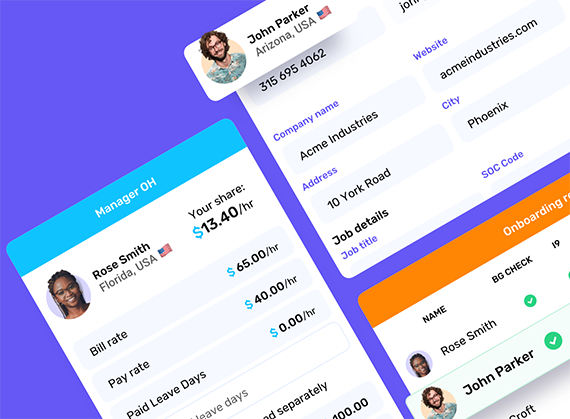Just as with anything that is unfamiliar or outside a person’s comfort zone, there is a huge fear factor involved with contract staffing. Many recruiters believe contracting is extremely complicated and too different from direct hire. But as the popularity of contract staffing services continues to grow, more recruiters are taking the leap and are finding that contract placements are really not as different from direct hire as they thought.
Similarities between a direct placement staffing agreement and a contract placement
Consider the main steps of a contract placement:
- Get the job order.
- Locate the candidate.
- Negotiate rates.
- Employ the contractor and handle the employment tasks. (Outsource)
You will notice that the first three steps are things you already do for direct hires. The rates are a little different when it comes to a contract placement, but once you understand the process for determining the hourly contract bill rates and markups that will be charged to the client company, it is easy. There is even potential for overlap in the case of a contract conversion.
So when it comes down to it, the biggest difference between direct hire and contract placements is the employment of the contractor and the “back-office” tasks associated with being the legal employer. Fortunately, those tasks can be outsourced to a contract staffing back-office, leaving you with the tasks that you are already well familiar with.
Direct Hire vs. Contract
If you decide you do NOT want to outsource, you need to allow yourself plenty of ramp up time before you start taking contract placements. You will need to get set up to withhold taxes and obtain Workers’ Compensation insurance in each state in which you plan to place contractors. You’ll want to decide how you will fund payroll (by yourself or through a third party funding company). You will need to decide if you are going to offer a Contract Employee Benefits Package (or if you are required to under the Affordable Care Act) and get those benefits set up. These are just some of the biggest setup tasks to consider if you want to be the legal employer. You also want to make sure that you have sufficient administrative support (both human and electronic) to handle the day-to-day tasks associated with acting as employer of record and offering recruitment back-office solutions, including:
- Legal contracts with the contractor and the client
- Payroll processing (on at least a biweekly basis)
- Tax withholdings and filing
- Background checks and drug screenings
- Unemployment claims
- Workers’ Compensation
- Invoicing clients and managing accounts receivables
- Benefits administration, if applicable
- Employee issues
- Employee terminations
- Keeping up with and complying with the complicated web of local, state, and federal employment laws
This whole back-office piece is what scares many recruiters off. But again, if you outsource this piece, you are left with the typical recruiting tasks. Just be sure to select a FULL-SERVICE back-office that will become the legal employer of your contractors and handle ALL of the employment tasks and legal liability. Otherwise, you may find yourself still wrangling with complicated contractor issues when you should be focusing on revenue-producing recruitment tasks.





